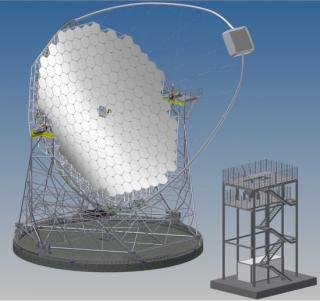
This section includes scientific and technological news from the IAC and its Observatories, as well as press releases on scientific and technological results, astronomical events, educational projects, outreach activities and institutional events.
-

-
 This Friday, October 9th at five o’clock in the afternoon, the ceremony of the stone laying for the biggest Cherenkov telescope in the northern hemisphere, the prototype of the LST (Large Size Telescope) with a diameter of 23 metres, will take place at the Roque de los Muchachos Observatory (ORM) on the island of La Palma. Takaaki Kajita, newly awarded the Nobel Prize for Physics, will be present at the event.Advertised on
This Friday, October 9th at five o’clock in the afternoon, the ceremony of the stone laying for the biggest Cherenkov telescope in the northern hemisphere, the prototype of the LST (Large Size Telescope) with a diameter of 23 metres, will take place at the Roque de los Muchachos Observatory (ORM) on the island of La Palma. Takaaki Kajita, newly awarded the Nobel Prize for Physics, will be present at the event.Advertised on -
 The “100XCIENCIA” forum has brought together for the first time all 20 of che Severo Ochoa centres of excellence, with science popularization as the linkAdvertised on
The “100XCIENCIA” forum has brought together for the first time all 20 of che Severo Ochoa centres of excellence, with science popularization as the linkAdvertised on -
Pere Estupinyà is a biochemist. He gave up on his doctorate in genetics to devote his efforts to the popularization of science. He has published two books of this kind, and we will shortly be seeing him on television. He will be one of those participating in “100xCIENCIA” and he thinks highly of an event where the Severo Ochoa centres of excellence can meet together with specialists in outreach, and science journalists.Advertised on
-
Pampa García Molina is the Editor-in-Chief of one of the most highly valued projects of science news and outreach in Spain. This is the SINC Agency, an agency for quality news backed by the FECYT (Spanish Foundation for Science and Technology). She will be one of the lecturers at the “100XCIENCIA” forum, and she is convinced that this will be a great opportunity to spread the word about the most outstanding research centres in the country.Advertised on
-
Rosa M. Tristán is one of the pioneers of the speciality of Science and the Environment in the Spanish press. She was the founder of the first section dedicated to these matters in a national newspaper -El Mundo- which for her meant “a privileged gateway to knowledge” as she herself puts it. Now she is working among other projects, in her own medium “Laboratory for sapiens”, with its own news section and a good number of subscribers and visits. She will be one of the participants in the “100xCIENCIA” forum where communicators and scientists will debate about their respective roles in theAdvertised on